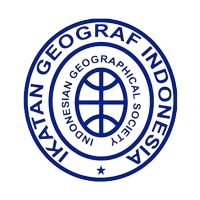TOPONIMI DESA DIKECAMATAN TILONGKABILA BERDASARKAN FAKTOR GEOGRAFI
DOI:
https://doi.org/10.31851/swarnabhumi.v8i2.8184Keywords:
Geographic Factor, Non-Physical, ToponymyAbstract
Tilongkabila is one of the districts in Bone Bolango regency. which consists of 14 villages. Every village possesses different toponyms and historical backgrounds, i.e., Berlian, Bongohulawa, Bongoime, Bonggopini, Butu, Iloheluma, Lonuo, Motilango, Moutong, Permata, Tamboo, Toto Utara, Tungulo, and south Tungulo village. This research aimed to study toponym geography in TilongkabilaDistrict.It employed a qualitative descriptive method and spatial approach analysis. The data was collected through observation, interviews, documentation, and library research. The result showed two factors related to the basis of village toponymy in Tilongkabiladistrict. First, non-physical geographic factors (social and cultural aspects)were measured by 78%. Further, physical factors such as the embodiment aspect are influenced by 27%. All in all, the study concluded that non-physical geographic factors influenced the village toponymy in TilongkabilaDistrict.
References
Anggini, A. (2016). Pemanfaatan Pantai
Ayah Sebagai Sumber Belajar Geografi Kelas X Materi PokokHidrosfer Sma Negeri SumpiuhTahun Ajaran 2014/2015. JurnalGeografi Volume 13 No. 2 –hlm.(115-224).
Anshari, dkk. 2017. “Kajian Etnosemantik
Dalam Toponimi Wilayah Kabupaten dan Kota Cirebonâ€. PROSIDING Laboratorium Leksikologi dan Leksikografi, Hal 64-69. ISSN: 2407-1307.
Ayanovna, N. L. (2014). The Role of
OldTurkic Place Names in TeachingHistory. Procedia - Social andBehavioral Sciences 141 (2014 )1054 – 1061.
Badan Pusat Statistik Tilongkabila 2020
Danandjaja, J. (1994). Folklor Indonesia
(Ilmu Gosip, Dongeng dan lain-lain).Jakarta:Grafiti.
Liliweri, Alo. 2014. Sosiologi dan
Komunikasi Organisasi. Jakarta : PT
Bumi Aksara.
Mursidi, Agus dan Dhalia Soetopo. 2018.
Toponimi Kecamatan Kabupaten Pendekatan Historis. Banyuwangi.
Rais, Jacob, dkk. 2008. Toponimi Indonesia:
Sejarah Budaya Bangsa yang panjang dari permukiman manusia dan tertib adminstrasi. Jakarta: Pradnya Paramita
Sandy, I Made. 1985. Republik Indonesia
Geografi Regional. Jakarta: Depdikbud.
Sudaryat, Yayat. 2009. Makna dalam
Wacana (Prinsip-prinsip Semantik dan Pragmatik). Bandung: Yrama Widya
Suhardjo, A.J. (2013). Filsafat sains
geografi. Dalam Suhardjo, A.J., dkk., Filsafat Sains Geografi. Yogyakarta: Penerbit Deepublish.
Yunus, Hadi Sabari, 2010. Metodologi
Penelitian Wilayah Kontemporer. Yogyakarta: Pustaka Pelajar.
Downloads
Published
Issue
Section
License
Copyright (c) 2023 JURNAL SWARNABHUMI : Jurnal Geografi dan Pembelajaran Geografi

This work is licensed under a Creative Commons Attribution-ShareAlike 4.0 International License.

Jurnal Swarnabhumi : Jurnal Geografi dan Pembelajaran Geografi by http://www.univpgri-palembang.ac.id/e_jurnal/index.php/swarna is licensed under a Creative Commons Attribution-ShareAlike 4.0 International License.











